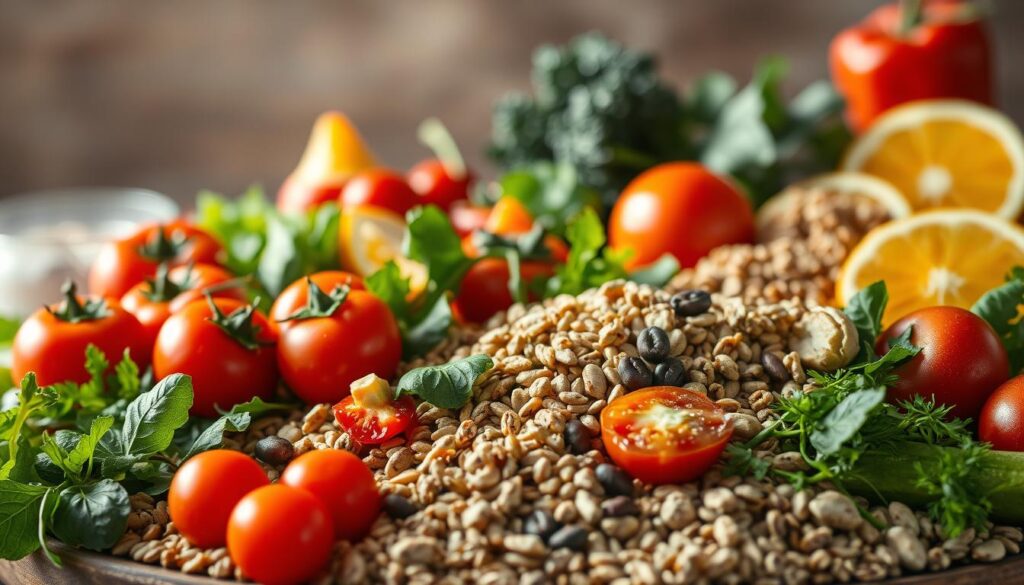Is your plate actually balanced, or are hidden pitfalls like ultra-processed foods and sugary drinks undermining your nutrition goals?
This guide shows that healthy eating is more than just counting calories. It’s about eating a balanced plate with 50% veggies and fruits. Whole grains and proteins should make up 25% each. It also talks about how food choices affect the environment and our health.
Food production is a big contributor to greenhouse gases. But, 80% of heart disease cases can be prevented by making smart food choices. Learn how to eat well without feeling restricted.
Key Takeaways
- Vegetables and fruits should cover half your plate for optimal nutrient intake.
- Ultra-processed foods make up nearly 50% of some diets, emphasizing the need for whole foods.
- Reducing sugary drinks and prioritizing home-cooked meals aligns with both health and sustainability goals.
- The Healthy Eating Plate avoids classifying potatoes as vegetables due to their blood sugar effects.
- Combining nutrition tips for wellness with regular meals and mindful eating prevents chronic disease risks.
Understanding What Makes a Diet “Healthy”
A healthy diet focuses on nutritious food choices and a balanced diet plan. It supports our bodies and long-term health. The World Health Organization (WHO) says a good diet lowers disease risks. It must meet our needs and be backed by science.

The Role of Nutrition in Overall Wellness
A balanced diet plan gives us the nutrients we need. This includes proteins, carbs, fats, vitamins, and minerals. These help our immunity, energy, and repair cells.
The WHO suggests adults eat less than 5 g of salt a day. They also recommend eating lots of fruits and veggies. Too much sugar can lead to diabetes and dental problems.
- Protein: 10–35% of daily calories
- Carbs: 45–65% of calories from complex sources
- Fats: 20–35% of calories, prioritizing unsaturated fats
Beyond Weight Loss: Health as the Primary Goal
“Health is a state of complete physical, mental and social well-being, not merely the absence of disease.” — WHO
Good nutrition helps us sleep better, feel happier, and live longer. The WHO has goals for 2025 to fight diabetes and obesity. They focus on eating nutrient-rich foods, not just cutting calories.
Eating whole foods like greens, lean proteins, and grains keeps us energized and healthy.
Individual Variation in Dietary Needs
Everyone needs different amounts of calories. Men need about 2,500 kcal a day, women about 2,000 kcal. Our genes, how active we are, and our health also play a part.
For example, athletes need more protein. People with high blood pressure should eat less salt. Our food choices are also influenced by our culture. So, diets should be flexible but still based on solid science.
What is the Best Diet for Healthy Living?
Health experts say the best diet focuses on clean eating for health and meets individual needs. No single diet works for everyone, but some key principles help make good choices. For example, the Mediterranean diet is known for lowering heart disease risks in Greece and Italy.
It emphasizes eating lots of vegetables, whole grains, and healthy fats. 
- Ensure complete nutrition with varied nutrients.
- Choose sustainable habits adaptable to lifestyle and culture.
- Support personal health goals and medical requirements.
- Promote a positive, non-restrictive relationship with food.
The World Health Organization recognizes the Mediterranean diet as a benchmark for healthy eating patterns.
Important parts include eating moderate amounts of fish (2–3 times a week), less red meat, and using olive oil or nuts instead of saturated fats. Adding diet and exercise for well-being makes things even better. Foods high in fiber and low in sodium also help lower heart disease risks.
By focusing on whole foods and making thoughtful choices, people can create diets that fit their lives without sacrificing health.
Core Principles of Nutritious Eating Patterns

Building healthy eating habits starts with key principles. These focus on nutrient-rich foods and balance. The USDA’s MyPlate model shows how to spread out food groups: veggies, fruits, whole grains, lean proteins, and healthy fats.
Nutrition tips for wellness tell us to stay away from ultra-processed foods. These foods are linked to higher death rates. Instead, choose whole foods like fatty fish and leafy greens.
Getting the right mix of macronutrients is key for energy and body function:
- Proteins (10-35% of calories) help repair muscles—go for eggs, legumes, and lean meats.
- Carbohydrates (45-65%) power the brain; pick whole grains and fiber-rich fruits over sugary ones.
- Fats (20-35%) should be unsaturated, like avocados and nuts, and avoid trans fats.
Vitamins and minerals are vital to avoid deficiencies. Get iron from spinach, calcium from fortified plant milks, and vitamin D from salmon or sunlight. Cooking at home lets you control the quality of your food better than pre-packaged meals.
Include both soluble (oats, beans) and insoluble (whole grains, carrots) fiber. Start with small amounts to avoid stomach issues. Aim for 25-30g daily from various plant-based foods.
Drinking enough water is crucial for cells and metabolism. Active people need 3-4 liters a day. Check your urine color to see if you’re hydrated, and avoid sugary drinks.
Popular Evidence-Based Dietary Approaches
Scientifically backed diets help us eat better for our health. The Mediterranean, DASH, and plant-based diets are great examples. They show how eating right can prevent chronic diseases and improve our metabolism.

| Approach | Key Components | Health Outcomes |
|---|---|---|
| Mediterranean | 30% plant-based fats (olive oil), ≥3 servings vegetables/day | 30% reduced cardiovascular events vs low-fat diets |
| DASH | SBP reduction of 5.5 mmHg vs control diets | |
| Plant-Based | Legumes ≥3x/week, unsaturated fats preferred | Reduced NCD risk markers (p |
| Whole-Food | Minimally processed foods, ≤1 added sugar serving/day | 25% lower metabolic syndrome risk |
Practical implementation tips:
- Mediterranean: Substitute red meat with twice-weekly fish servings
- DASH: Use American Heart Association’s Heart-Check certification for packaged foods
- Plant-Based: Include calcium-fortified plant milks for nutrient completeness
- Whole-Food: Prioritize seasonal produce to enhance nutrient retention
Following these diets can lower the risk of diseases. They match WHO’s advice on eating whole grains and veggies. The clean eating for health idea is key. It focuses on getting the right nutrients, not just counting calories. Mixing these diets makes a balanced diet plan that fits your needs and is backed by science.
Creating Your Balanced Diet Plan
Creating a balanced diet plan means mixing science with what you like. Begin by keeping a food diary to see what you eat. This helps spot missing nutrients. Then, set goals that match your health needs, like losing weight or fighting chronic diseases.
- Plate Proportions: The NHS suggests half your plate for veggies and fruits. The other half should be whole grains and lean proteins. For instance, add veggies and quinoa to a 700-calorie steak dinner to make it balanced.
- Portion Control: Adults need 2,000 calories a day. Eat 80g of fruits and veggies as portions. Swap sugary snacks for nuts or carrot sticks to get nutrients without extra calories.
- Flexibility: Change portion sizes based on how active you are. Active people might need 2,600 calories, while less active ones should stick to 2,000. Focus on whole foods to cut down saturated fats by 30%.
Start healthy eating by planning meals wisely. Swap high-calorie restaurant meals for homemade ones with grilled chicken, avocado, and brown rice. Use apps like MyFitnessPal to track your progress and follow the 5-a-day rule. Include lean proteins like salmon twice a week for omega-3s and choose low-fat dairy for calcium.
For diabetes, cut down carbs to one-quarter of your plate. Follow the NHS 12-week plan to slowly switch to whole grains. This boosts fiber by 50%. Regularly check and update your plan to keep up with your life changes.
Mindful Eating Practices for Long-Term Success
Mindful eating focuses on being aware of hunger, fullness, and food choices. It helps make better food choices by listening to our body’s signals. Studies show it makes meals more satisfying and helps avoid overeating.
Recognizing Hunger and Fullness Cues
It’s important to know the difference between hunger and emotional eating. Here are some signs to look out for:
| Physical Hunger | Emotional Hunger |
|---|---|
| Gradual onset | Sharp, urgent |
| Open to any food type | Craves specific foods |
| Stops at fullness | Continues eating past fullness |
Breaking the Emotional Eating Cycle
Stress and feeling alone can lead to eating more comfort foods. The pandemic saw a 65% increase in people seeking help for emotional eating. Here are some ways to break this cycle:
- Keep a journal of when you eat and why
- Take a moment to check if you’re really hungry before eating
- Try breathing exercises for 10 minutes before meals
Practical Mindfulness Techniques
Here are some easy ways to practice mindful eating:
- Start meals with a short ritual, like deep breathing
- Chew each bite slowly to help with digestion
- Stop eating halfway to see if you’re still hungry
A 12-week study found these techniques cut down binge eating by 34% and improved blood sugar control. Mindful eating helps build lasting habits that support healthy eating, not just quick fixes.
Integrating Clean Eating Habits Into Daily Life
Starting clean eating for health means making simple changes. First, organize your kitchen to focus on nutritious food choices. Keep whole foods like fruits, veggies, and lean proteins easy to grab. Move processed snacks to harder spots.
- Meal prep stations: Set aside a shelf for pre-chopped veggies and grains
- Batch cooking: Cook big batches of things like quinoa or chicken for fast meals
- Restaurant swaps: Choose grilled meats over fried and ask for dressings on the side
| Clean Eating Choice | Non-Clean Alternative |
|---|---|
| Steel-cut oats with berries | Sugary cereal |
| Grass-fed ground beef | Processed deli meats |
| Homemade vinaigrette | Store-bought creamy dressings |
A 2023 study in the Journal of Nutrition showed eating whole foods can cut belly fat by 18% in 12 weeks. Here are some key steps:
- Use apps like MyFitnessPal to track what you eat
- Follow USDA tips for reading food labels
- Shop the grocery store’s outer aisles for fresh foods
American Heart Association research found eating more whole grains can lower heart disease risk by 23%. It’s important to find a balance. 71% of young adults feel better when they eat less processed food. But, 49% of Instagram users might struggle with eating too clean. Focus on making progress, not being perfect, to keep your mind healthy.
Complementary Lifestyle Choices for Optimal Health
For optimal health, we need to mix physical activity, sleep, and stress management with what we eat. These habits work together to keep us well.
Exercise and Movement Synergy with Nutrition
Working out boosts the good effects of diet and exercise for well-being. For instance, a 2018 study showed that high-protein meals can lower hunger better than high-carb ones. Eating protein after exercise helps with recovery and muscle fixing. Here are some tips:
- Match exercise intensity with calorie intake (e.g., higher protein on training days)
- Hydrate with electrolytes during prolonged activity
- Choose whole foods like eggs or lean meats to sustain energy
Sleep Quality and Its Impact on Dietary Choices
Poor sleep messes with hunger hormones, making us want more high-calorie foods. A 2017 study found that enough sleep helps control appetite. Here’s what happens when we don’t sleep well:
| Hormone | Effect of Sleep Deprivation | Impact on Diet |
|---|---|---|
| Leptin | Reduced levels | Increased hunger signals |
| Ghrelin | Raised levels | Elevated appetite |
Stress Management for Digestive Wellbeing
Stress can slow down digestion and change how we absorb nutrients. Mindfulness, like deep breathing or yoga, can help. Here are some tips:
- Practice 10-minute mindful breathing daily
- Incorporate probiotic-rich foods to support gut microbiota
- Limit caffeine to reduce digestive irritation under stress
Conclusion: Building a Sustainable Healthy Eating Lifestyle
Choosing a healthy lifestyle means matching your diet to your needs and caring for the planet. Eating whole, nutrient-rich foods and being mindful of what you eat are key. The Mediterranean and plant-based diets show how good for you and the planet they can be.
Mindful eating practices help you understand when you’re hungry and what you’re eating. Studies show eating more plant-based foods can lower death risk by 12% and help the environment. Livestock is a big source of greenhouse gases, making plant-based meals a big win for the planet.
Only 1 in 10 Americans eat enough fruits and veggies, according to the CDC. We need to plan better and learn more about healthy eating. Programs in California and Iowa show how we can make food systems healthier and more sustainable.
It’s important to keep making changes to your diet. Check if your eating habits still match your health and environmental goals. Even small steps, like eating less meat or composting, can make a big difference. By focusing on whole foods and being mindful, you can help yourself and the planet for years to come.





